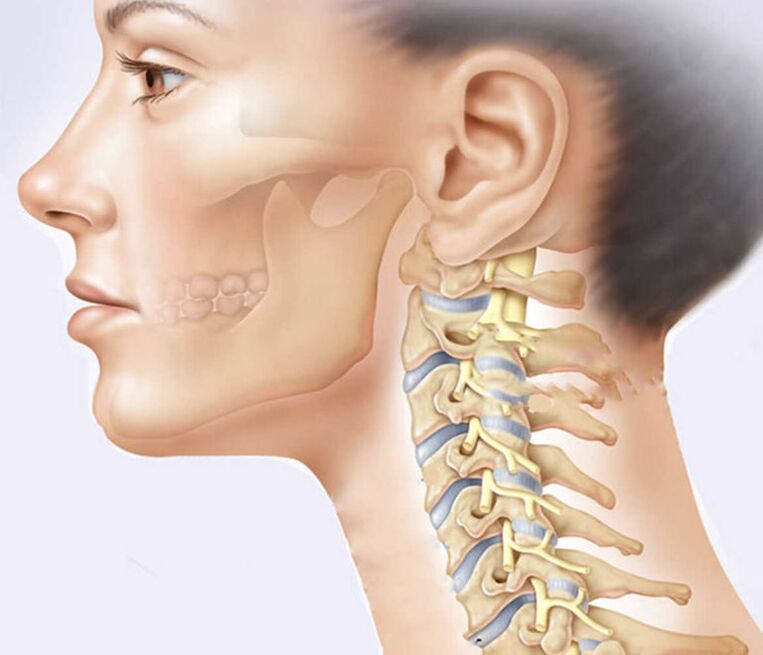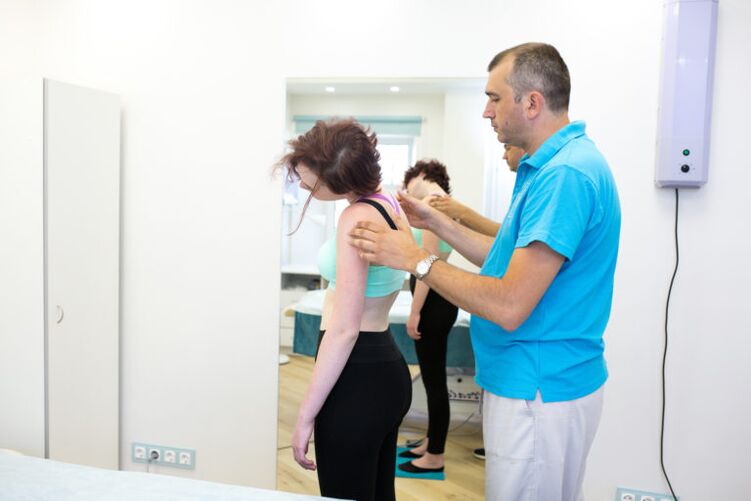Everyone experiences severe pain in the neck. This does not necessarily mean an accident or an abnormality in the structure of the vertebrae. Improper workplace organization, sedentary lifestyle, intense physical activity - all these can lead to severe pain. With age, the manifestations of osteonecrosis can be complex, and diseases of the internal organs only add to the problem.
Neck pain can come on suddenly, such as when turning the head or tilting sharply. It can radiate to the head (mostly the back of the head), chest, or even shoulders. Such phenomena are usually the result of cervicogenic (cervical) lumbago or acute muscle spasms. We stand in the draft, lifting a heavy object - severe neck pain can last 5-10 days, but then it goes away. If pain persists for more than 10 days, they are sharp, aching or throbbing, significantly reducing quality of life - you should seek treatment.

Because many lymph vessels, large veins, and arteries pass through the cervical region, any problems in them must be treated carefully. The cervical musculoskeletal cavity contains the thyroid gland, pharynx, the first part of the esophagus, the larynx, and the upper part of the trachea. The neck muscles are involved in the movement of the head, shoulders, and even the jaw. Therefore, if you have neck pain, you should see your doctor right away to find the cause and prevent some serious problems.
The doctors will check the condition of your spine and brain, take X-rays, CT or MRI, and check the tension in the muscles of your neck, shoulders, and upper back. Determining the cause of the pain may lead to no need for treatment in the cervical spine. You should also be prepared to make exercise a part of your daily life.
Severe pain in the cervical spine is a very important and practical problem in neurology. Its importance is determined by the following factors:
- Neck pain with osteonecrosis is the most common non-infectious disease.
- Pain in the neck tends to turn chronic with exacerbations. Frequent severe pain can lead to temporary or even permanent disability.
These factors determine the importance of seeking prompt medical attention. If you feel discomfort or pain, you should see a specialist immediately. Self-treatment in such cases is unacceptable, as it can cause serious complications.
In addition, self-medication often leads to surgery and disability in adults.
Only a doctor can expertly prescribe treatment, including pain relief.
Types of neck pain
Differentiate between cervical pain (cervical pain) and cervical low back pain (cervical pain). The cervix is:
- superficial somatic - associated with skin lesions;
- deep somatic - due to damage to the muscles and cervical vertebrae;
- visceral - scattered, arising from infection or disease of internal organs.
Cervical effects affecting adjacent areas are divided into two types:
- neck pain - cervicobrachial syndrome with pain radiating from the neck down to the shoulder;
- cervicogenic pain - pain that begins directly in the cervical or occipital region, and spreads to the head.
Cervicitis of all types can be acute or chronic. The acute phase lasts about 10 days, but without proper treatment, it can become chronic. Chronic pain is considered to last more than three months.
Cervicago is always an acute pain localized in the cervical spine and does not allow you to turn your head.
If the discomforts are due to neuropathy, they can be central (with spinal cord injury) or peripheral (peripheral nerve damage).
Causes of neck pain
Generally, the causes of neck pain can be divided into two groups - arising from diseases of the spine or from other factors. The previous diseases were formed against the background of disc herniation, osteoarthritis, dysfunction of the joints, as well as compression of the vertebrae (vortex disease). The consequences of these injuries can be felt throughout life. The second group includes neck pain caused by infections and endocrine disorders, tumor processes, rheumatic diseases.
Some of the most common causes of neck pain include:
- Myofascial syndrome.It occurs against the background of prolonged excessive strain of the neck muscles, sprains, hypothermia. They usually cause short-term pain of moderate intensity, in which head mobility is often limited and muscles spasm. When pressed, it feels painful and hard. Usually, the pain from myofascial syndrome goes away on its own within 4-5 days.
- Cervical spine tumor. This disease is a degenerative-dystrophic lesion of the spine, which occurs due to the deformation and destruction of the intervertebral discs. Due to the disc's loss of elasticity, compression and destruction, the joints are overloaded, dry joints appear, and nerve roots are compressed. This leads to the fact that the whole neck hurts a lot. With age, the hydrophilicity of cartilage decreases, leading to a decrease in the distance between the vertebrae and damage to the disc joints.
- Dysfunction of the facet joints.Structural damage to the disc joint is one of the most common reasons for total neck pain. Cartilage becomes thinner on the joint surface. This causes the appearance of bone growth - bone-forming substances. They narrow the lumen of the openings between the vertebrae, causing nerve endings to become pinched. As a rule, this is accompanied by a dull pain (gradual, low intensity) in the neck region, which is more intense in the morning after sleeping in an uncomfortable position - lying on a high pillow, lying on his stomach. With exercise, the pain may increase, but with rest, the pain will weaken. In this case, pain may radiate to the back of the head, ears, temples, and shoulders.
- Discs and convex.Due to the compression of the discs, the discs lose their elasticity, protrusion - protrusion into the spinal canal with the subsequent formation of herniation. This leads to compression of the spinal cord, which disturbs the sensitivity of the hand - numbness, burning, weakness, and is accompanied by pain. The intensity of the shot (uneven side) increases when crouching, turning, or throwing back. Therefore, a person must instinctively tilt their head forward and to the opposite sides to locate the pain.
- Cervical myelopathy. . . Long-term compression of the hernia disrupts blood circulation in the spinal cord. Because of this, it's not just the whole neck that hurts a lot. But the violation is accompanied by pain that radiates to the area between the shoulder blades and to the shoulder. They get worse with exercise and don't go away even with pain medication. Characteristic signs of neck pain when suffering from cervical spondylosis are goosebumps, numbness of hands and feet, and fine motor disorders. Sometimes there may be dizziness, memory loss, gait changes.
- Whip wound.They arise due to a sharp bend of the neck backward or forward, followed by a recoil in the opposite direction. Such injuries often occur in an accident, but even an ordinary fall to the back can cause them. Trauma occurs due to stretching and damage to the muscles and ligaments of the discs and cervical vertebrae. The most severe cases are accompanied by dislocations and fractures. As a result of the injury, the entire neck and shoulders can be very sore, migraines appear, and muscle spasms occur. Accompanying symptoms include blurred vision, increased fatigue, and frequent headaches.
In addition, neck pain can be caused by hypertonia syndrome. This is a condition that causes prolonged spasms of certain muscle groups in the head, chest, and neck. Compression by neuromuscular activators leads to pulling, sometimes very intense pain. In particular, vertebral muscle syndrome is a complex symptom, which is accompanied by a violation of the clarity and blood circulation of the squamous muscles of the neck, which pass from the cervical vertebra to the first and second ribs. This syndrome is characterized by pain and stiffness of the cervix, which is most common in the morning. The head in such cases is usually tilted forward and slightly towards the tensor muscle. The pain can be mild, aching, but sometimes sharp, more intense at night, when breathing deeply, when tilting the head to the healthy side. Sometimes there may be radiating pain in the shoulder, in the armpit and interstitium, as well as in the anterior chest.

However, the cause of the pain is not only the pathology of the spine. First of all, it is necessary to exclude infectious diseases, namely, nonspecific spondyloarthritis or tuberculosis, epidural abscess. Metastatic lesions of the vertebrae may also be accompanied by persistent pain that does not subside but worsens with rest. They are characterized by an increase in body temperature, general weakness and sweating. Even a small amount of pressure on the spines causes local pain.
Risk factors for pain include flat feet, arched posture, and strenuous exercise. Cervical pain may occur with continuous overuse, vibration, or prolonged immobility of the body (eg, fracture).
In addition, pain can be caused by wearing tight and uncomfortable clothing, malnutrition, and diseases of internal organs. Taking these factors into account, we receive numerous clinical cases in which cervicitis is formed.
Neck pain: who to contact and what to do
If the neck is in pain, traditional medicine provides drug treatment with different types of drugs. They are designed to combat pain, reduce infectious or inflammatory processes and eliminate unpleasant symptoms. Surgery is only done in very severe cases.
Drug therapy is based on the use of local anesthetics, analgesics (NSAIDs), hormonal drugs (glucocorticoids), muscle relaxants (medications to reduce muscle tension), antioxidants, and, if necessary, antidepressants and anticonvulsants. Analgesic-based therapy - drugs from other groups are prescribed as concomitant medications to enhance the analgesic effect, reduce inflammation and swelling.

The downside of drug treatment is a lot of side effects and temporary pain relief. Also, such treatment is aimed only at eliminating the symptoms, but in no way directed at the root cause of the pain.
Who should be entrusted with such an important part of the body - the neck? In the case of severe pain, there is no need for a specialist but a careful medical examination, accurate diagnosis and prescription of therapy.
An integrated approach is applied, based on a combination of the following non-pharmacological approaches:
- Physical therapy.Neck muscles are difficult to exercise, so when choosing exercises, experts pay attention to the mobility of the ribcage, shoulders and neck, as well as evenly distribute the load on the spine. Therapists select the optimal set of exercises to correct posture and eliminate neck pain.
- Kinetic therapy.Clinics use kinetic therapy systems. The installation allows you to deeply train the muscles of the cervical spine. With the help of closed chain exercises, neuromuscular problems of the skeleton can be effectively managed and enhanced function of the organ.
- Osteopathy.Safe, painless neck alignment, suitable for adults and children, pregnant women and professional athletes. Unlike other treatments, osteopathic medicine not only eliminates the pain syndrome, but also helps the patient get rid of the source of the pain, treating the underlying diseases. For this, palpation and manual manipulation techniques are used on the muscles, joints, nerves, connective tissue, vessels and capillaries of the neck. Osteopathic medicine methods accelerate the recovery process, increase the effectiveness of treatment, prevention or rehabilitation measures.
- Manual therapy.It effectively relieves neck tension. Specialist doctors gently affect biological acupuncture points, eliminate urinary incontinence, displacement, and perform manipulations aimed at relaxing neck muscles and stretching the spine.
Competent selection and the right combination of therapeutic methods eliminates neck pain and gets rid of unpleasant sensations. An integrated approach involves the harmonious coordination of different specialists - rehabilitation physicians, neurologists, traumatologists, orthopedists, psychologists. All of them follow the common goal of reducing pain for the patient. An individual approach to everyone is important, a combination of chiropractic and physical therapy procedures and even work to address the underlying mental causes of neck painso many, so much.

















































